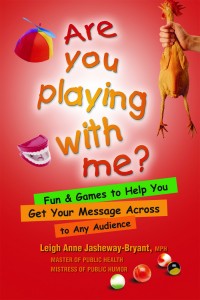Pushing People Past
Their Comfort Zone to Play Games
Without Pushing Their Buttons
Excerpted from Are You Playing with Me?
By Leigh Ann Jasheway
In an earlier blog, we talked about how reluctant some people can be in being playful. It may not be their nature. Or a light heart may be something that is frowned upon in their department or their profession. If someone asked me to sit quietly without cracking a smile for an hour, I’d feel very uncomfortable (actually, I’d probably find it impossible), so every time I ask someone to step outside their usual boundaries, I try to conjure up a picture of myself sitting in a chair silently. And then I try not to laugh at the idea.
When it comes to playful activities, there are four types of people. People who:
1. Are not done being a child and need no encouragement to be silly and childlike;
2. Can be coaxed into playfulness fairly easily if everyone else is doing it;
3. May have forgotten how to play and will need a lot of convincing; and
4. Never feel comfortable showing or even admitting they have a playful side. You may be able to get them to sit at the table, but they’ll probably stare at you or have an “emergency phone call” they have to take.
You can coax or cajole the first three types into participating, but with the resisters, all you can do is hope they eventually feel compelled to join in due to peer pressure. Here are my favorite ways to get audiences involved in activities that may be outside their usual comfort zone:
- Make it clear that yours will not be a staid lecture. From the title, to the description, to the handouts, to the nametags, incorporate playfulness and fun so that no one will be shocked when they get there.
- Create a playful environment by arranging the room for fun – the closer the better, semi-circles instead of straight lines, and tables so they can make eye contact with one another. Also set the mood with props and lighting. I like to use strings of light shaped like flamingos or chili peppers. Seeing fun lights automatically says “Hey, this could be different!”
- Get a feeling about the group and how supportive or distant they are by arriving early for networking or a meal. Set the tone with your own playful attitude. Joke and laugh with them before the actual presentation. This reduces their inhibitions, puts them in a more jovial mood, and reinforces that your presentation will probably be non-traditional.
- Write your own introduction and make it funny, highlighting some of the more playful aspects of your own personality. I use things like:
–She has an M.P.H., which either stand for Masters of Public Health or Mistress of Public humor.
–When she’s not speaking or writing, she wrangles wiener dog at her ranch.
–In a previous lifetime, she’s sure she left the iron on.
Use fun music to start and end your session, or to mark breaks.
Near the beginning of your presentation, highlight the productivity, creativity, team building, health, emotional, stress managing, or other benefits of what you’ll be asking them to do. This will address the concern of the more reticent people of the “reason” they should be involved.
Build love and support into the group and activities; discourage meanness disguised as playfulness. I usually tell my groups what things are off-limits, such as making fun of people, using sarcasm instead of humor, saying anything they wouldn’t want their boss or mother to hear, etc. You may also want to use this funny Carmen Miranda Rights statement.
Carmen Miranda Rights: You have the right to remain silent. You will probably not have as much fun or learn as much, but it is your right to sit quietly and observe until such time as you are ready to be part of the merriment.
As long as you aren’t a bully and don’t hurt anyone else while playing, nothing you say (or do) can or will be used against you in your workplace.
You have the right to a play coach. That is why I’m here – to encourage and inspire you to get in touch with your less serious side so that you can take a breather from the problems of your day and your life.
You also have the right to wear fruit on your head. (See cartoon above.)
Deal with people’s fears and concerns. One way to do this is to have them name them right up front. Make a list on a flip-chart under the heading, “Why I’m scared to play” or “Reasons my funny bone is broken.” It helps when people hear that they aren’t the only ones concerned about something. And if they can laugh at their fears together, it creates the kind of bonding that helps throughout their experience.
- Keep a variety of games and fun activities in your toolbox so that you can pick things that are most likely to work for the group you face.
- Give lots of praise and applause. It is amazing what people will do if you encourage them simply with recognition.
Forming groups
Once you set the stage for playfulness and fun, you will find that many of the games in this book require you to break down a large audience into smaller, manageable groups. This can cause a lot of trainers and speakers problems – how do you get the people from the same departments to spread out and meet new people? It can feel a lot like dealing with junior high school cliques when you’re faced with an audience who is most comfortable staying with the people they know best.
There are many easy and fun ways to form new groups. You can break them into teams by:
- Color of shoes or socks.
- Natural hair color.
- Which of the following cartoons they like the most: Garfield, Charlie Brown, B.C., The Simpsons, South Park, Opus, none of the above.
- Listing five barnyard animals (cow, sheep, chicken, pig, farm cat). Have them choose one, make that kind of noise, close their eyes and wander about until they find the rest of their herd or flock.
- Using a quickie questionnaire with questions you can use throughout the day to break into different groups:
—What’s your favorite color?
—Paper or plastic?
—How many children were in your family?
—What’s your major hobby?
—If you were a tree, what kind would you be?
—Name your favorite ice cream.
—What kind of dog did you grow up with? Or was it a cat?
—Which type of music do you prefer?
—Favorite cereal as a child?
—Etc. - Having them play Rock/Paper/Scissors and putting all the rocks, all the papers, all the scissors together in groups.
- Players reach out and touch someone. Everyone closes their eyes and walks around until you say stop. Then they reach out hands (eyes still closed) until they find the right number of hands for the group.
- Using toys. Have as many different types of toys as you want groups and have each person choose one. Their toy represents their group.
- There is no end to the methods you can use to divide people up into smaller groups, although I don’t recommend sawing them in half. Just make it fun and quick and everything will flow from there.





